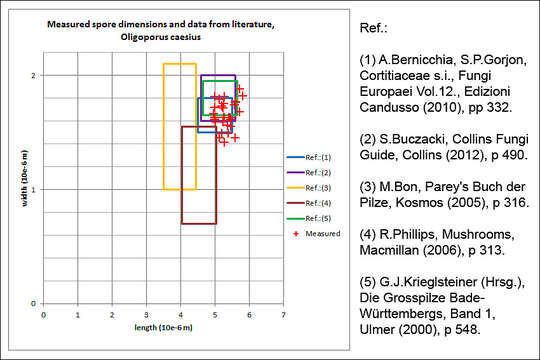Postia-subcaesia_2Ma

Description:
Postia subcaesia, syn.: Oligoporus subcaesius, Tyromyces subcaesius, Spongiporus subcaesiusBlueing Bracket, Blauer SaftporlingSlo.: modrikasti skutovecDat.: Oct. 09, 2013 Lat.: 46.39815 Long.: 13.70048Code: Bot_759/2013_DSC8535Habitat: Mixed forest, Picea abies and Fagus sylvatica dominant, almost flat terrain, calcareous ground; full shade; humid place, partly protected from direct rain by tree canopies; average precipitations ~ 3.000 mm/year, average temperature 4-6 deg C, elevation 1.000 m (3.300 feet), alpine phytogeographical region.Substratum: on dead rotting branch lying on ground and on rotten half buried roots of Fagus sylvatica, partly still in bark.Place: Zadnja Trenta valley, left bank of (mostly) dry Soa river bed, north of Bavki Grintavec mountain, East Julian Alps, Posoje, Slovenia EC Comments: This observation was first determined as Postia caesia (see former text in brackets below). But, a kind explanation of Mr. Gnter Sturm, Germany, having long 'mileage' in Polyporaceae, and the paper of David (1974), Ref.: (8) convinced me that the correct determination should be Postia subcaesia. Now substratum fits better. Also habitus of the find fits better to the new determination. Pileus of P. caesia is of more uniform colors and never as strongly zonate as in this observation. Another trait, which fits better now, is the fact that the pilei color didn't changed distinctly blue when bruised. Nevertheless, spore dimensions still don't fit to data from literature. May be Ryvarden's comment in Ref.: (7), p 405, regarding distinguishing both species: 'However, there are some disturbing intermediate specimens on hardwoods.' explains the situation?Former text:[This beautifully blue polypore could eventually be Oligoporus subcaesius. Unfortunately, the distinguishing traits between O. caesius and O. subcaesius seem to be treated quite inconsistently in the literature available to me. Oligoporus caesius should principally thrive on wood of conifers (with rare but documented exceptions) and should have spores wider than 1.5 , while Oligoporus subcaesius is found on broadleaved trees and should have spores narrower than 1.5 (as per Ref.:(5) and Ref.:(1)). Contrary, Ref.: (4) states narrower than 1.5 spores for O. caesius (a typo?). Also the information about spore shape (allantoid versus cylindrical) is inconsistently given in different sources. In this observation measured spore width speaks in favor to O. caesius (according to Ref.:(1) and (5)), while substratum doesn't support this decision. Since exceptions with regard to substratum are known, and based on quite distinctively blue color of the pilei and their size (O. subcaesius should be significantly larger according to Ref.:(1)) I decided for O. caesius, but this may be incorrect. ]Growing in a small group of about 6 pilei of different size; pilei up to 6 x 4 cm across; flesh soft, fibrous; SP very faint, whitish(?), oac857(?).Spores smooth, cylindrical and moderately allantoid. Dimensions: 5.3 (SD = 0.2) x 1.6 (SD = 0.1) , Q = 3.25 (SD = 0.26), n = 30. Olympus CH20, NEA 100x/1.25, magnification 1.000 x, oil, in water. AmScope MA500 digital camera.Herbarium: Mycotheca and lichen herbarium (LJU-Li) of Slovenian Forestry Institute, Vena pot 2, Ljubljana, Index Herbariorum LJFRef.: (for Postia subcaesia)(1) Personal communication with Mr. Mr. Gnter Sturm. Id'ed by Mr. Gnter Sturm.(2 ) J. Breitenbach, F. Kraenzlin, Eds., Fungi of Switzerland, Vol.2. Verlag Mykologia(1986), p274.4.5-5.5/1-1.2(3) A. Bernicchia, Polyporaceaes.l., Fungi Europaei Vol.10., Edizioni Candusso (2005), pp 359.4-6/1-1.2(4) S. Buczacki, Collins Fungi Guide, Collins (2012), p 490. 4.5-5.5/1-1.2(5) R. Phillips, Mushrooms, Macmillan (2006), p 313. 4-5/0.7-1.5(6) G.J. Krieglsteiner (Hrsg.), Die Grosspilze Baden-Wrttembergs, Band 1, Ulmer (2000), p 560.4.5-5.5/1-1.5(7) L. Ryvarden, R.L. Gilbertson, European Polypores, part 2., Synopsis Fungorum 7., Fungiflora A/S (1994), p 435.4-5/1-1.4(8) A. David, Une nouvelle espece de Polyporaceae: Tyromyces subcaesius, Bull. Soc.Linn. Lyon, Vol.46. (1974), pp 119-126. 4-5/1-1.25(2)Ref.: (for Postia caesia)(1) A. Bernicchia, Polyporaceaes.l., Fungi Europaei Vol.10., Edizioni Candusso (2005), pp 332. (2) S. Buczacki, Collins Fungi Guide, Collins (2012), p 490. (3) M. Bon, Parey's Buch der Pilze, Kosmos (2005), p 316. (4) R. Phillips, Mushrooms, Macmillan (2006), p 313. (5) G.J. Krieglsteiner (Hrsg.), Die Grosspilze Baden-Wrttembergs, Band 1, Ulmer (2000), p 548.
Included On The Following Pages:
- Life (creatures)
- Cellular (cellular organisms)
- Eukaryota (eukaryotes)
- Opisthokonta (opisthokonts)
- Nucletmycea
- Fungi (mushrooms, lichens, molds, yeasts and relatives)
- Dikarya
- Basidiomycota (basidiomycete fungi)
- Agaricomycetes (Mushroom-Forming Fungi)
- Polyporales
- Fomitopsidaceae
- Postia
- Postia caesia
This image is not featured in any collections.
Source Information
- license
- cc-by-nc-sa
- copyright
- Amadej Trnkoczy
- photographer
- Amadej Trnkoczy
- original
- original media file
- visit source
- partner site
- Flickr Group
- ID


